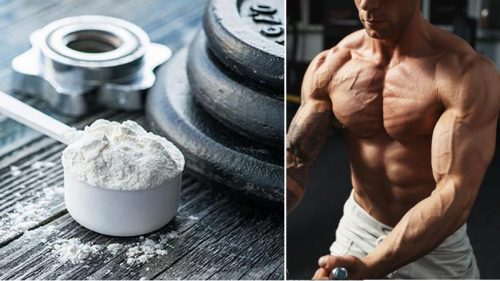Not all creatine products are created equal. One of the “problems” creatine supplements have is absorption. In order for creatine to be effective, it needs to be absorbed properly. The longer it stays in your stomach, it degrades and loses its effectiveness.
We are going to tell you what can you do to increase the absorption rate very easily. There are a lot of companies out there “inventing” new types of creatine like Creatine Phosphate or Creatine Citrate. Creatine Phosphate ads extra Phosphate creating Phosphocreatine, while Creatine Citrate (aka effervescent Creatine) is supposed to aid with absorption.
Studies have not confirmed a significant difference between using Creatine Monohydrate the right way (we’ll get to this in a moment) and Creatine Phosphate or Citrate, especially not one that would justify the huge price difference. Don’t become a victim of these marketing gimmicks.
When to take creatine to maximize its results?
To understand when is the best time to take creatine, you have to be familiar with 3 terms: loading phase, maintenance phase and cycling. Don’t worry if you don’t know what they mean, we’ll go through it together.
Loading Phase. The loading phase is when you first start taking creatine and try to build up creatine in your muscles as much as you can, as quick as you can (saturating the muscle cells with creatine). In the loading phase it’s recommended to take 4 doses of creatine of 5 grams (a tea spoon). You should take one when you wake up, one before your workout, one after your workout and one before going to bed in the evening.
The loading phase will get you faster results, but not necessarily the best.
The loading phase should take 5-7 days and should be followed by the maintenance phase.
Maintenance Phase. This is when you only take one dose of creatine per day (5 grams) to maintain the level of creatine in your muscles. The recommended use is to split the one dose in half and take one before workout and the other after. It’s debatable how long you should use creatine long term, but lets take a few facts in consideration.
Facts you should consider:
- Creatine remains active in your system several weeks after stopping (assuming you have taken enough creatine to saturate your muscles)
- You can skip the loading phase. Creatine will build up faster in the loading phase, however studies have shown at the end of 30 days, both maintenance and loading phase have the same results.
- While no studies have shown that cycling is needed (by cycling I mean stopping the creatine intake for a while), we suggest taking it for 2 months, 1 month break and than 2 months on again. The best results you’ll see in the first 30 days, so it makes sense to “recreate” that. After the break you can enter the loading phase again and get the same results over and over.
- Another reason why it’s prudent to cycle is that while taking creatine supplements, you body might stop producing creatine on its own, since you already have enough supplies. There are no tests to prove the argument one way or the other, but it’s one of those situations when you want to be better safe than sorry.
- Creatine works almost any time of the day, so that’s why you may hear a lot of stories from different people. 80 out of 100 stories though, will tell you it’s best you take creatine before and after workout.
Now, that you have understood the when, let’s jump into the how.
How to take creatine to maximize its results?
Like we mentioned in the beginning, the problem with creatine is the absorption. You want it to be transported fast from your stomach to your muscles. The longer it stays in the stomach, the longer it decays and becomes useless because of the action of your stomach acid.
We’re gonna call the “transporter” for faster results. And no, I don’t mean Jason Statham
Our transporter is named insulin. Insulin is a hormone that carries glucose in cells where it’s deposited as glycogen. But insulin is not only a transporter for glucose.
It can transport other substances like …. well, you guessed … creatine.
All, we have to do know is provoke a spike of insulin, to help the rapid transport of creatine from stomach to muscles.
In order to do that, you need carbohydrates. Carbohydrates in the stomach break down into glucose, that gets absorbed in the blood, which triggers the insulin.
Now, that you know how it works, it will tell you what you need to do. Whenever you take Creatine supplements, you need to also take carbohydrates.
A list of common sources of carbohydrates you can use:
- Warm liquids like coffee and tea. Add some sugar also — that’s a powerful source of carbohydrates
- Sports Drinks, Kool-Aid, Energy Drinks
- Fruit Juice like cranberry or grape juice that have high concentration of glucose. Not all fruits will have glucose. In fact, you should stay away from lemon, orange or grapefruit juice. They have a high concentration of vitamin C, which can degrade creatine. It’s a theory, but again, better safe than sorry.
- Potatoes (baked, boiled), sweet potatoes, bananas, grapes can be another great source of carbohydrates.
- Protein shakes/gainers can also do the job
Make sure to drink at least a glass of water after you’ve taken creatine and carbohydrates. It helps emptying the stomach.



Post your comment